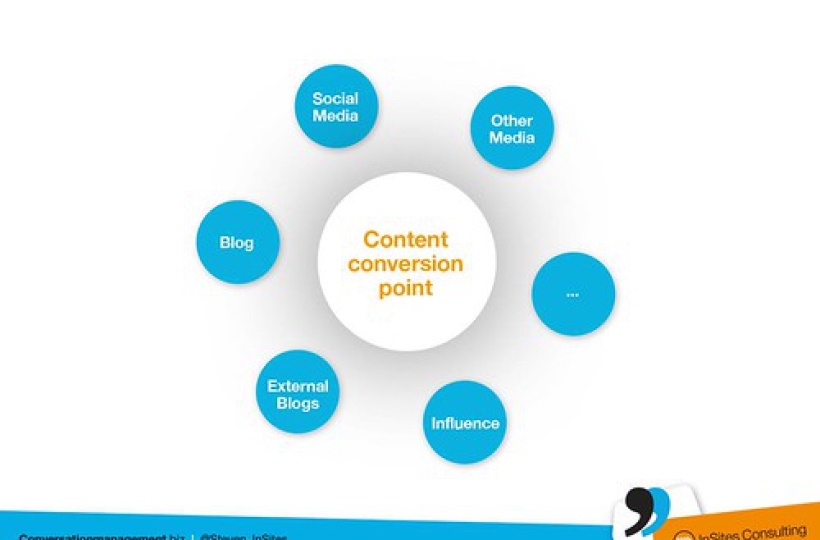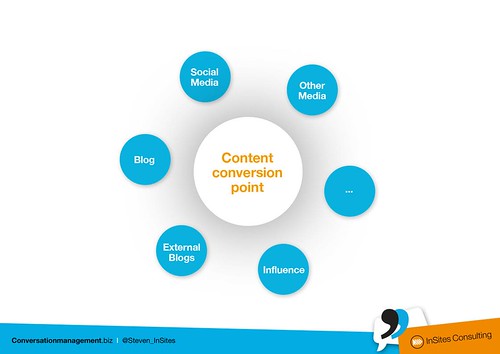Content Marketing Step 2: Content Conversion plan

In the past few days, we gave an overview of a pragmatic content marketing approach. In this post, we will zoom in on the second step of the process: moving from content to conversion.
Case study: Hubspot from zero to hero in two years
Hubspot is an American software company. Their software helps companies to establish new leads via various channels, such as social media, but also via Google and other websites. The company was founded in 2004 but enjoyed its most spectacular growth between 2009 and 2011. In those two years, their number of customers rose from 1,400 to 3,600. Their philosophy is very close to that of a Conversation Company. The Hubspot culture is very open and authentic. They believe in the power of conversations between staff and consumers to support their growth. In 2010, the company was chosen as ‘Best Place to Work in Greater Boston’ (David Meerman Scott in: Real time marketing & PR).
Hubspot invests in a very smart content strategy. They have three objectives. Firstly, they want to be seen as the opinion leader in their domain. Secondly, they want to become more findable in Google searches. Thirdly, they want to increase their reach on social media. With these aims in mind, they publish new content every day on their blog, on YouTube, on other blogs, on SlideShare, etc. Within a relatively short period of time, they scored as the best company in their sector for all three of their objectives. The figures for their blog are particularly impressive. 10% of all visitors to the blog subsequently find their way to the company website. Between 10 and 20% of these people become leads (“Hoe Hubspot succesvol werdâ€, Dutch). The company thinks like a publisher or newspaper editor: they must have an interesting article every day. And until now, they continue to find them! This allows them build up greater online reach which they can instantly convert into sales.
From content to conversion
As Hubspot shows, the ultimate purpose of a content strategy is to attract new customers or persuade existing customers to re-buy. To achieve this, you will need to draw up a touch-point content plan. Include in this plan all touch-points where a (potential) customer can come into contact with your content. Then decide at which of these touch-points conversion to sales is likely to occur. In the case of Hubspot, the converting touch-point is their website. 20% (one in five) of all visitors to the website will contact the company for more information. Their blog is the touch-point that leads people from the content area to the sales area. Their social media accounts ensure that there is sufficient daily traffic to the blog.
Rabobank also has a similar plan. One of their target groups is starter-entrepreneurs. To offer useful free advice to these people, they have created a content site: ‘I’m going to start!’ (Dutch). Starters who are impressed by the information on this site can click on a link to the main Rabobank site, where the actual conversation takes place.
For companies working in the knowledge sector, SlideShare can be used as a useful converting touch-point. SlideShare is a social network site where people can share presentations (PowerPoint, etc.). This is the ideal place to show what you can do and what you have to offer. In this way, it is often possible to directly convert a reader into a sales lead.
The compilation of a content plan can perhaps best be compared with putting together a football team. Your ultimate objective is to score. To do so, you need to get the ball to your strikers. Some teams play a long ball game, so that the ball is played quickly and directly to your forward players. Other teams play a passing game, with lots of short combinations before finally whacking the ball into the goal. But no matter how you do it, getting the ball into the back of the net is the only thing that counts. You are the team coach, so it is for you to decide the best route to the goal. Every strategy has its advantages and its disadvantages, but one thing is certain: if you don’t have a strategy, you are not going to win anything at all.
[slideshare id=11438613&doc=asixstepcontentmarketingmodel-120206005134-phpapp01]
